Citroen C1 RHD 2016 1.G Owner's Manual
Manufacturer: CITROEN, Model Year: 2016, Model line: C1 RHD, Model: Citroen C1 RHD 2016 1.GPages: 268, PDF Size: 7.09 MB
Page 151 of 268
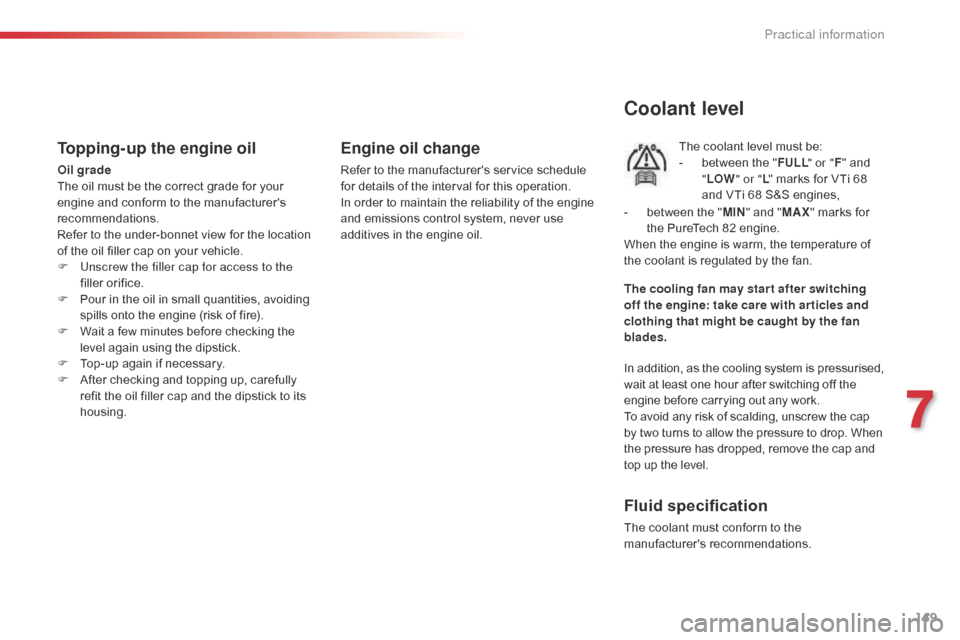
149
Topping-up the engine oil
Oil grade
The oil must be the correct grade for your
e
ngine and conform to the manufacturer's
r
ecommendations.
Refer
to the under-bonnet view for the location
o
f the oil filler cap on your vehicle.
F
U
nscrew the filler cap for access to the
filler
orifice.
F
P
our in the oil in small quantities, avoiding
s
pills onto the engine (risk of fire).
F
W
ait a few minutes before checking the
l
evel again using the dipstick.
F
T
op-up again if necessary.
F
A
fter checking and topping up, carefully
r
efit the oil filler cap and the dipstick to its
h
ousing.
Engine oil change
Refer to the manufacturer's service schedule for details of the interval for this operation.
In
order to maintain the reliability of the engine
a
nd emissions control system, never use
a
dditives in the engine oil.
Coolant level
The coolant level must be:
- b etween the "FULL " or "F"
and
"LO
W" or " L"
marks for VTi 68
a
nd VTi 68 S&S engines,
In
addition, as the cooling system is pressurised,
w
ait
at
least one hour after switching off the
e
ngine
before carrying out any work.
To
avoid
any risk of scalding, unscrew the cap
b
y
two
turns to allow the pressure to drop. When
t
he
pressure has dropped, remove the cap and
t
op
up
the
level.
Fluid specification
The coolant must conform to the ma nufacturer's r ecommendations.
The cooling fan may star t after switching
off the engine: take care with ar ticles and
clothing that might be caught by the fan
blades. -
b
etween the "
MIN " and "
MAX " marks for
t
he PureTech 82 engine.
When the engine is warm, the temperature of
t
he coolant is regulated by the fan.
7
Practical information
Page 152 of 268
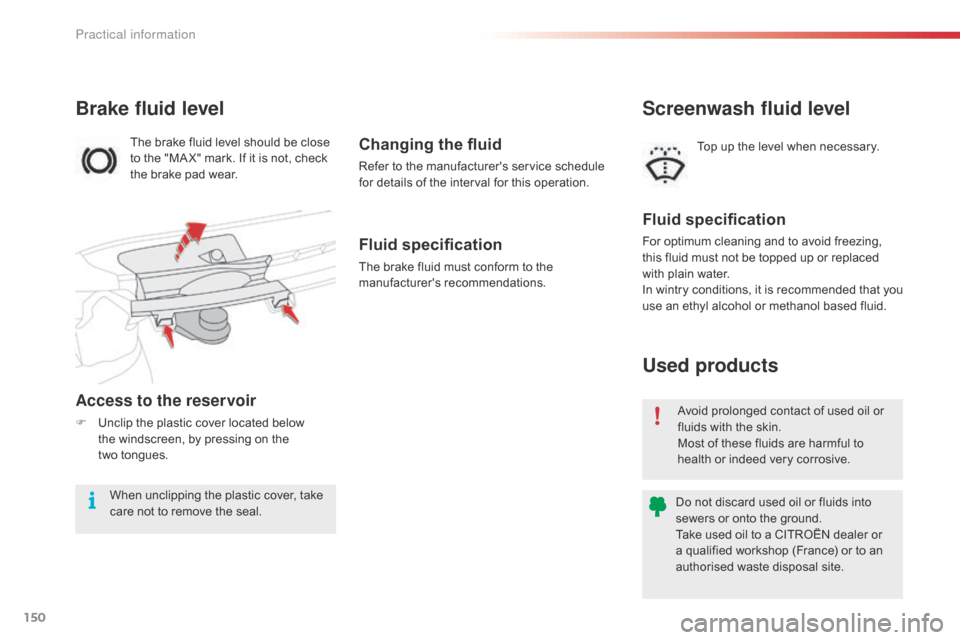
150
Avoid prolonged contact of used oil or fluids with the skin.
Most
of these fluids are harmful to
h
ealth or indeed very corrosive.
Do
not discard used oil or fluids into
s
ewers or onto the ground.
Take
used oil to a CITROËN dealer or
a
qualified workshop (France) or to an
a
uthorised waste disposal site.
Used products
Fluid specification
For optimum cleaning and to avoid freezing, this fluid must not be topped up or replaced
w
ith plain water.
In
w
intry
c
onditions,
i
t
i
s
r
ecommended
t
hat
y
ou
u
se an ethyl alcohol or methanol based fluid.
Screenwash fluid level
Top up the level when necessary.
T
he
brake
fluid
level
should
be
close
t
o
the
"MA X"
mark.
If
it
is
not,
check
t
he
brake
pad
wear.
Brake fluid level
Changing the fluid
Refer to the manufacturer's service schedule f or details of the interval for this operation.
Fluid specification
The brake fluid must conform to the manufacturer's r ecommendations.
Access to the reservoir
F Unclip the plastic cover located below t
he windscreen, by pressing on the
t
wo tongues.
When
unclipping the plastic cover, take
c
are not to remove the seal.
Practical information
Page 153 of 268
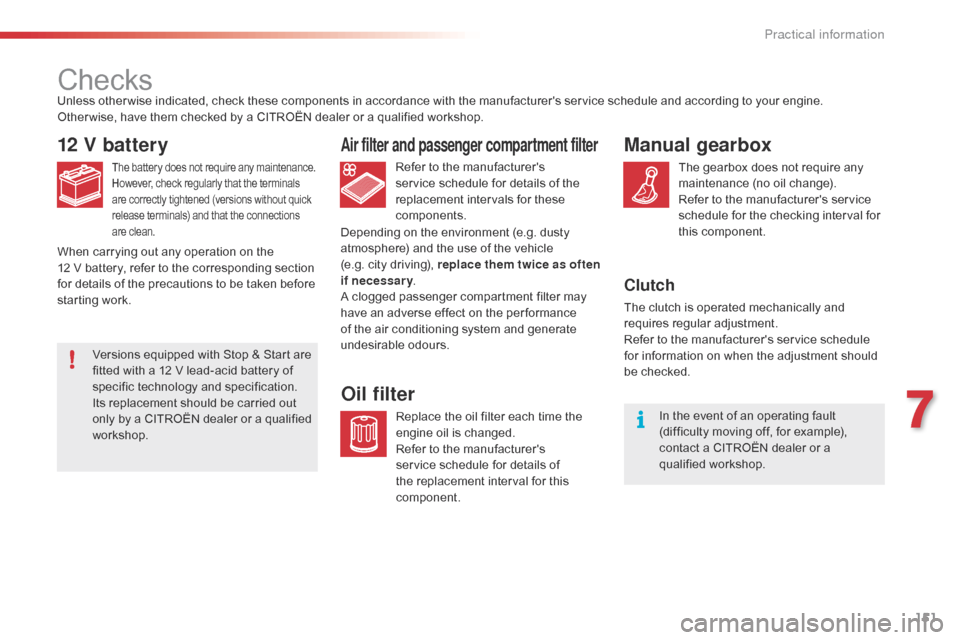
151
Checks
12 V battery
The battery does not require any maintenance.
H owever, check regularly that the terminals a
re correctly tightened (versions without quick
r
elease terminals) and that the connections
a
re clean.Refer to the manufacturer's service schedule for details of the
r
eplacement intervals for these
c
omponents.
Air filter and passenger compartment filter
Replace the oil filter each time the e ngine oil is changed.
Refer
to the manufacturer's
s
ervice schedule for details of
t
he replacement interval for this
c
omponent.
Oil filter
Unless other wise indicated, check these components in accordance with the manufacturer's service schedule and according to your engine.
O ther wise, have them checked by a CITROËN dealer or a qualified workshop.
Depending
on the environment (e.g. dusty
a
tmosphere) and the use of the vehicle
(e.g.
city driving), replace them twice as often
if necessary .
A
clogged passenger compartment filter may
h
ave an adverse effect on the per formance
o
f the air conditioning system and generate
u
ndesirable
o
dours.
When
carrying out any operation on the
12
V battery, refer to the corresponding section
f
or details of the precautions to be taken before
s
tarting work.
Manual gearbox
The gearbox does not require any maintenance (no oil change).
Refer
to the manufacturer's service
s
chedule for the checking interval for
t
his
c
omponent.
Clutch
The clutch is operated mechanically and requires r egular a djustment.
Refer
to the manufacturer's service schedule
f
or information on when the adjustment should
be c
hecked.In
the event of an operating fault
(
difficulty moving off, for example),
c
ontact a CITROËN dealer or a
q
ualified
w
orkshop.
Versions
equipped
with
Stop
&
Start
are
f
itted
with
a
12
V
lead-acid
battery
of
s
pecific
t
echnology
a
nd
s
pecification.
Its
replacement
should
be
carried
out
o
nly
by
a
CITROËN
dealer
or
a
qualified
w
orkshop.
7
Practical information
Page 154 of 268
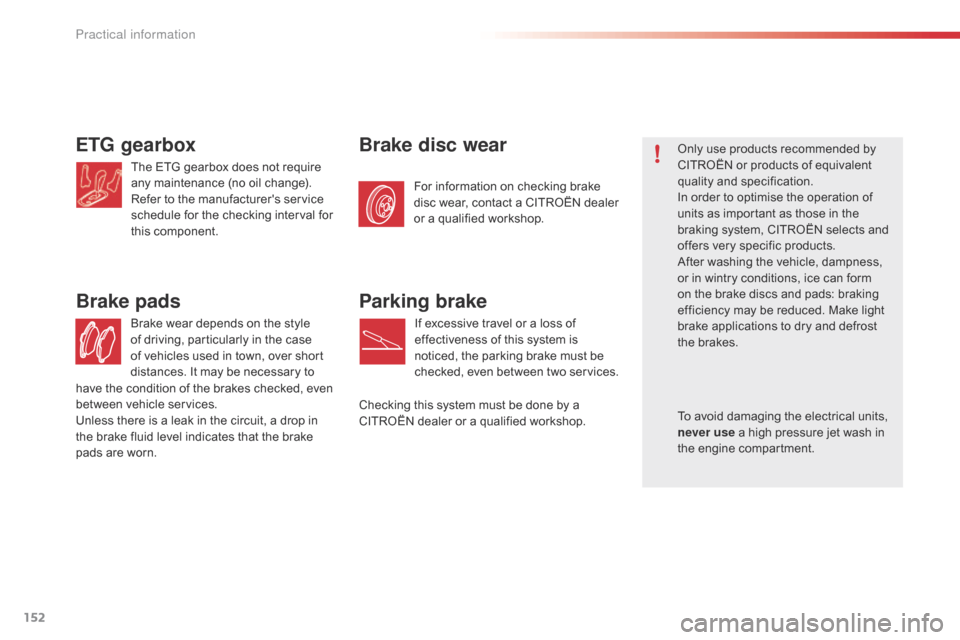
152
ETG gearbox
The ETG gearbox does not require any maintenance (no oil change).
Refer
to the manufacturer's service
s
chedule for the checking interval for
t
his
c
omponent.
Brake
wear depends on the style
o
f driving, particularly in the case
o
f vehicles used in town, over short
d
istances. It may be necessary to
Brake pads
For information on checking brake disc wear, contact a CITROËN dealer
o
r a qualified workshop.
Brake disc wearOnly use products recommended by CITROËN or products of equivalent
q
uality
an
d
sp
ecification.
In
order to optimise the operation of
u
nits as important as those in the
b
raking system, CITROËN selects and
o
ffers very specific products.
After
washing the vehicle, dampness,
o
r in wintry conditions, ice can form
o
n the brake discs and pads: braking
e
fficiency may be reduced. Make light
b
rake applications to dry and defrost
t
he brakes.
Parking brake
If excessive travel or a loss of effectiveness of this system is
n
oticed, the parking brake must be
c
hecked,
e
ven
b
etween
t
wo services.
Checking
this system must be done by a
C
ITROËN
dealer or a qualified workshop.
have
the
condition
of
the
brakes
checked,
even
b
etween
v
ehicle
s
ervices.
Unless
there
is
a
leak
in
the
circuit,
a
drop
in
t
he
brake
fluid
level
indicates
that
the
brake
p
ads
are
worn. To
avoid damaging the electrical units,
n
ever use a high pressure jet wash in
t
he engine compartment.
Practical information
Page 155 of 268
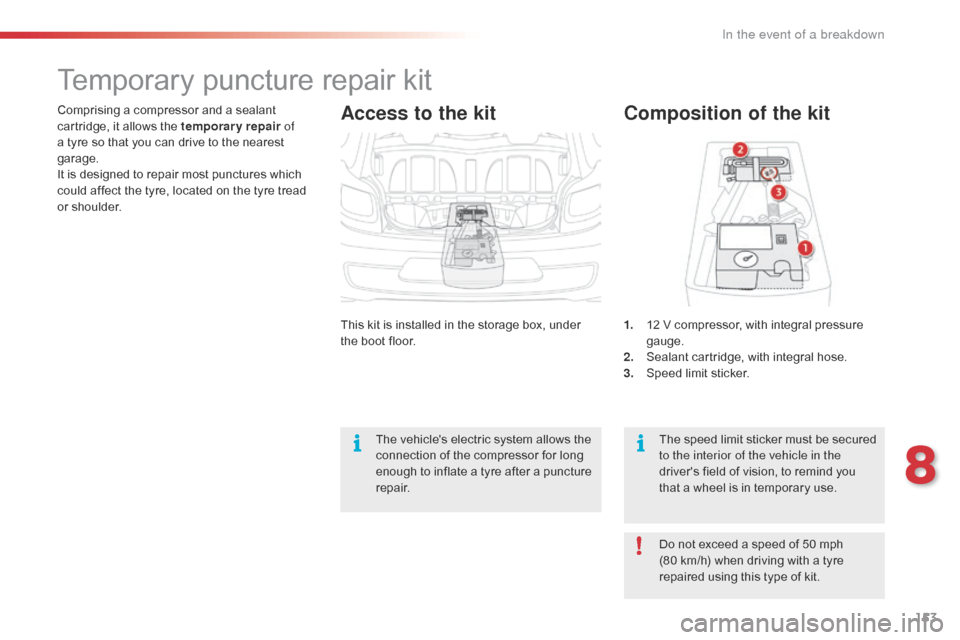
153
Comprising a compressor and a sealant cartridge, it allows the temporary repair of
a
tyre so that you can drive to the nearest
g
arage.
It
is designed to repair most punctures which
c
ould affect the tyre, located on the tyre tread
o
r shoulder.
Temporary pu ncture r epair k it
Composition of the kit
1. 12 V compressor, with integral pressure ga
uge.
2.
S
ealant cartridge, with integral hose.
3.
S
peed limit sticker.
The
speed limit sticker must be secured
t
o the interior of the vehicle in the
driver's
field of vision, to remind you
t
hat a wheel is in temporary use.
This
kit
is
installed
in
the
storage
box,
under
t
he boot
floor.
The
vehicle's
electric
system
allows
the
c
onnection
of
the
compressor
for
long
e
nough
to
inflate
a
tyre
after
a
puncture
r
epair. Do
not exceed a speed of 50 mph
(
80 km/h) when driving with a tyre
r
epaired using this type of kit.
Access to the kit
8
In the event of a breakdown
Page 156 of 268
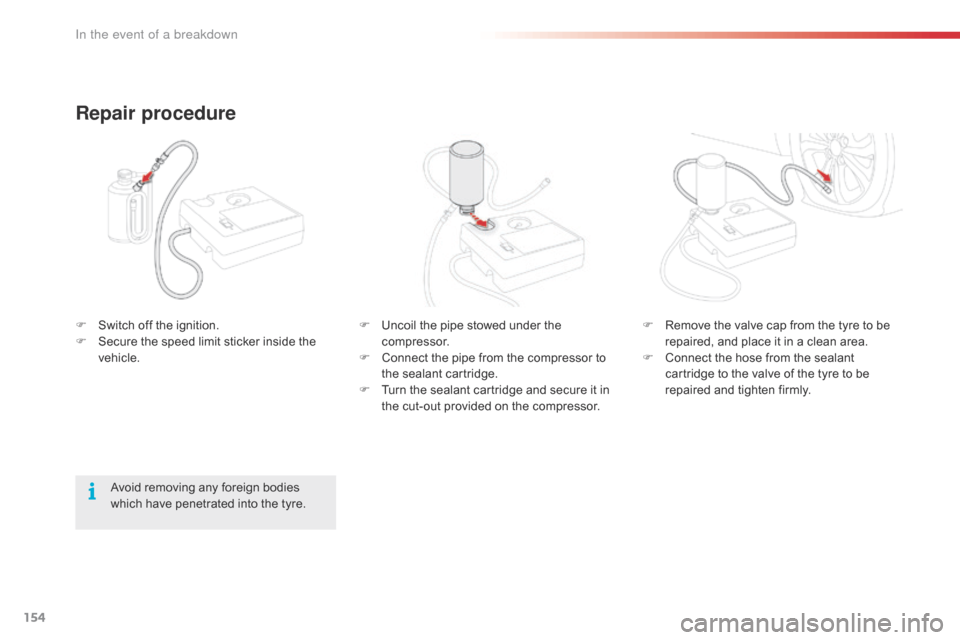
154
F Uncoil the pipe stowed under the c
ompressor.
F
C
onnect the pipe from the compressor to
t
he sealant cartridge.
F
T
urn the sealant cartridge and secure it in
t
he cut-out provided on the compressor.
Repair procedure
Avoid removing any foreign bodies which have penetrated into the tyre. F
R
emove the valve cap from the tyre to be
r
epaired, and place it in a clean area.
F
C
onnect the hose from the sealant
c
artridge to the valve of the tyre to be
r
epaired and tighten firmly.
F
S
witch off the ignition.
F
S
ecure the speed limit sticker inside the
v
ehicle.
In the event of a breakdown
Page 157 of 268
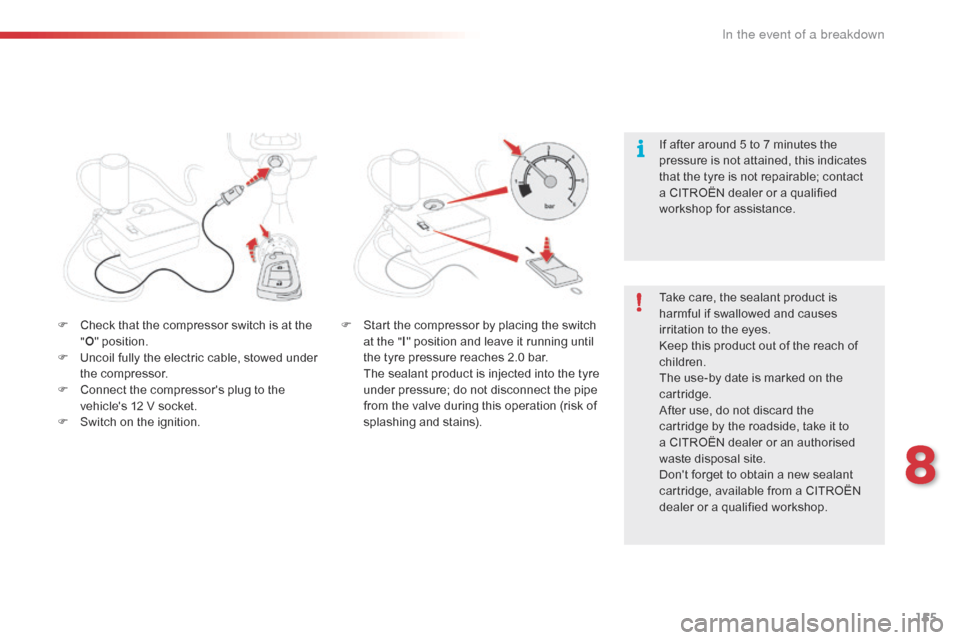
155
F Check that the compressor switch is at the "O "
position.
F
U
ncoil fully the electric cable, stowed under
t
he compressor.
F
C
onnect the compressor's plug to the
v
ehicle's 12 V socket.
F
S
witch on the ignition. Take
care, the sealant product is h
armful if swallowed and causes i
rritation to the eyes.
Keep
this product out of the reach of
c
hildren.
The
use-by date is marked on the
c
artridge.
After
use, do not discard the
c
artridge by the roadside, take it to
a
CITROËN dealer or an authorised
w
aste disposal site.
Don't
forget to obtain a new sealant
c
artridge, available from a CITROËN
d
ealer or a qualified workshop.
If
after around 5 to 7 minutes the
p
ressure is not attained, this indicates
t
hat the tyre is not repairable; contact
a
CITROËN dealer or a qualified
w
orkshop for assistance.
F S tart the compressor by placing the switch a
t the "I"
position and leave it running until
t
he tyre pressure reaches 2.0 bar.
T
he sealant product is injected into the tyre
u
nder pressure; do not disconnect the pipe
f
rom the valve during this operation (risk of
sp
lashing
an
d
s
tains).
8
In the event of a breakdown
Page 158 of 268
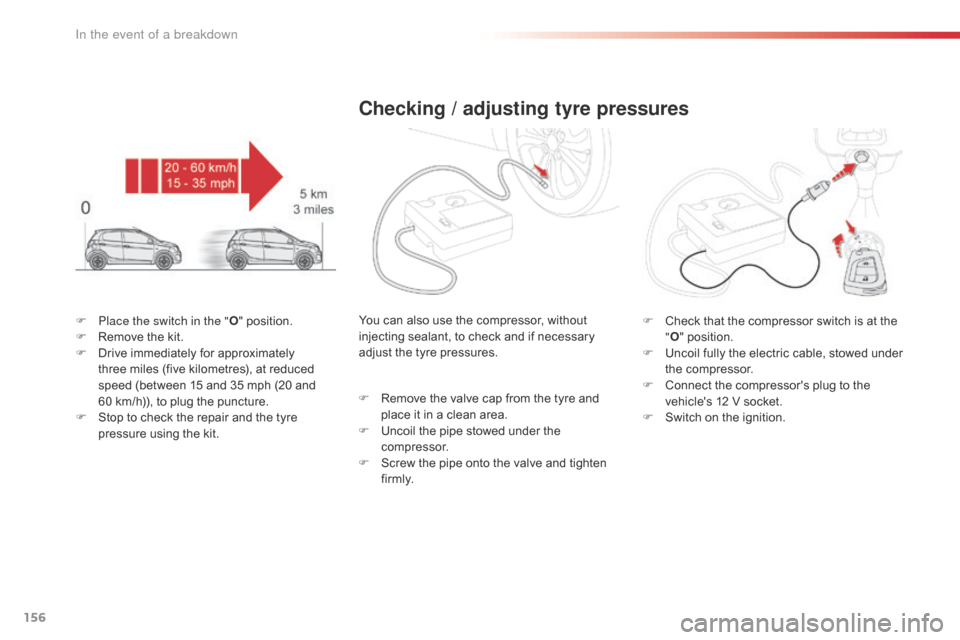
156
F Place the switch in the "O" position.
F R emove the kit.
F
D
rive immediately for approximately
t
hree miles (five kilometres), at reduced
s
peed (between 15 and 35 mph (20 and
6
0 km/h)), to plug the puncture.
F
S
top to check the repair and the tyre
p
ressure using the kit.
Checking / adjusting tyre pressures
F Check that the compressor switch is at the "O "
position.
F
U
ncoil fully the electric cable, stowed under
t
he compressor.
F
C
onnect the compressor's plug to the
v
ehicle's 12 V socket.
F
S
witch on the ignition.
You
can
also
use
the
compressor,
without
i
njecting
sealant,
to
check
and
if
necessary
a
djust
the
tyre
pressures.
F
R
emove
the
valve
cap
from
the
tyre
and
p
lace
it
in
a
clean
area.
F
U
ncoil
the
pipe
stowed
under
the
c
ompressor.
F
S
crew
the
pipe
onto
the
valve
and
tighten
f
i r m l y.
In the event of a breakdown
Page 159 of 268
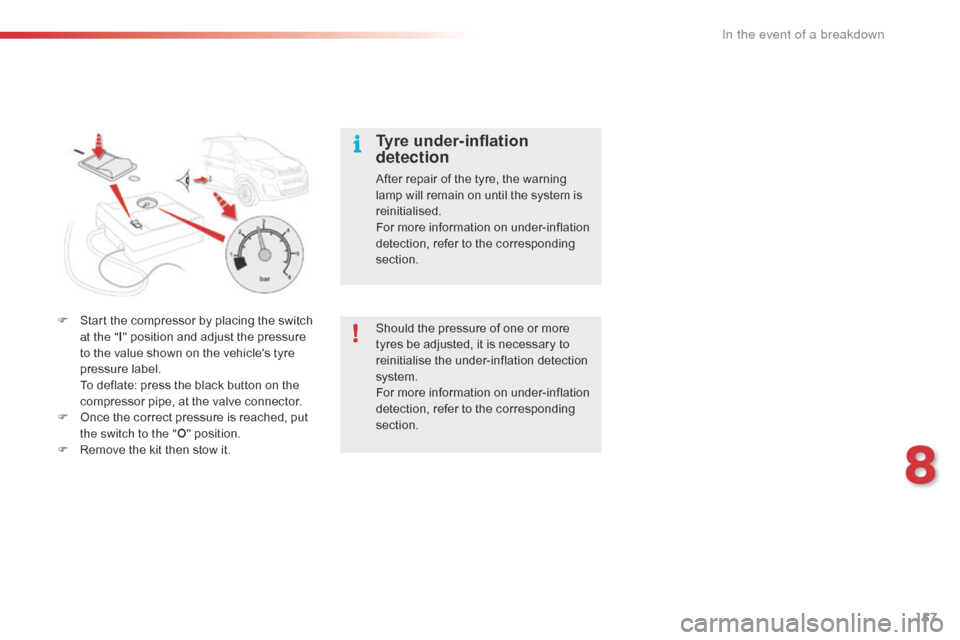
157
Should the pressure of one or more tyres be adjusted, it is necessary to
r
einitialise the under-inflation detection
s
ystem.
For
more information on under-inflation
d
etection, refer to the corresponding
s
ection.
Tyre under-inflation
detection
After repair of the tyre, the warning lamp will remain on until the system is
r
einitialised.
For
more information on under-inflation
d
etection, refer to the corresponding
s
ection.
F
S
tart
the
compressor
by
placing
the
switch
a
t the " I"
position
and
adjust
the
pressure
t
o
the
value
shown
on
the
vehicle's
tyre
p
ressure
label.
T
o
deflate:
press
the
black
button
on
the
c
ompressor
pipe,
at
the
valve
connector.
F
O
nce
the
correct
pressure
is
reached,
put
t
he switch to the " O"
position.
F
R
emove
the
kit
then
stow
it.
8
In the event of a breakdown
Page 160 of 268
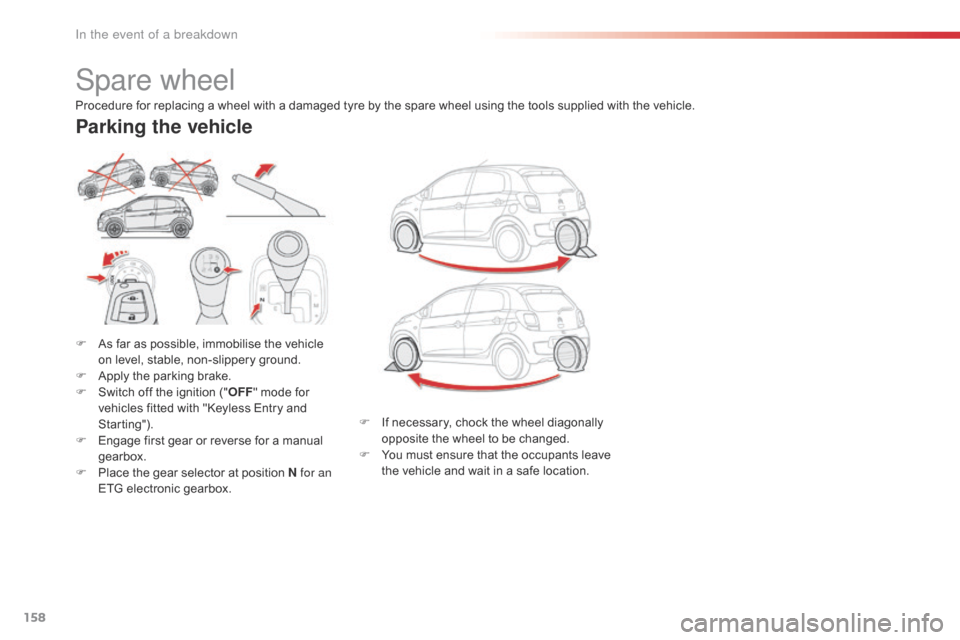
158
Spare wheel
F As far as possible, immobilise the vehicle o
n level, stable, non-slippery ground.
F
A
pply the parking brake.
F
S
witch off the ignition ("OFF "
mode for
v
ehicles fitted with "Keyless Entry and
S
tarting").
F
E
ngage first gear or reverse for a manual
g
earbox.
F
P
lace the gear selector at position N for an
ETG
electronic gearbox.
Parking the vehicle
Procedure for replacing a wheel with a damaged tyre by the spare wheel using the tools supplied with the vehicle.
F
I
f necessary, chock the wheel diagonally
o
pposite the wheel to be changed.
F
Y
ou must ensure that the occupants leave
t
he vehicle and wait in a safe location.
In the event of a breakdown